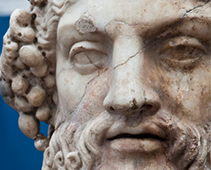Incense was burnt at religious services in sanctuaries and at ceremonies connected with cults of the dead. The fragrant smoke from the glowing
lumps of resin produced a euphoric state and created the feeling of divine presence among those present.
INCENSE
FRAGRANT INCENSE
In the Middle East there were very ancient traditions of burning fragrant incense to the gods. Images, texts and other finds tell us about rituals and implements. The smoke could be produced by the burning of aromatic plants and oils, but the finest incense was lumps of resin, which came from the Arabian peninsula. Here grew the bush-like tree, Boswellia, the resin of which, known more properly as frankincense, sent up clouds of fragrant smoke when laid on top of glowing charcoal. Myrrh was another – and even more costly – incense, obtained from the juice of the Commiphora bush.
By means of Arab caravans, lumps of these costly substances were brought to the ports of the Mediterranean, where Phoenician merchants traded them on to chieftains and princes in Greece, Italy and other destinations in the Western Mediterranean.
Incense was burnt at religious services in sanctuaries and at ceremonies connected with cults of the dead. The fragrant smoke from the glowing lumps of resin produced a euphoric state and created the feeling of divine presence among those present.
In sanctuaries and tombs, vessels and implements have been found, which bear witness to the widespread use of incense in ancient cultures. The resin itself has seldom survived, but a few traces are known from Etruscan tombs, where they were left for the use of the deceased in the next world.
Together with gold, frankincense and myrrh were the costliest presents one could offer a god or a prince. These were also the gifts of the Three Wise Men from the East, to the King of Kings, the newborn Jesus, that time in Bethlehem.




